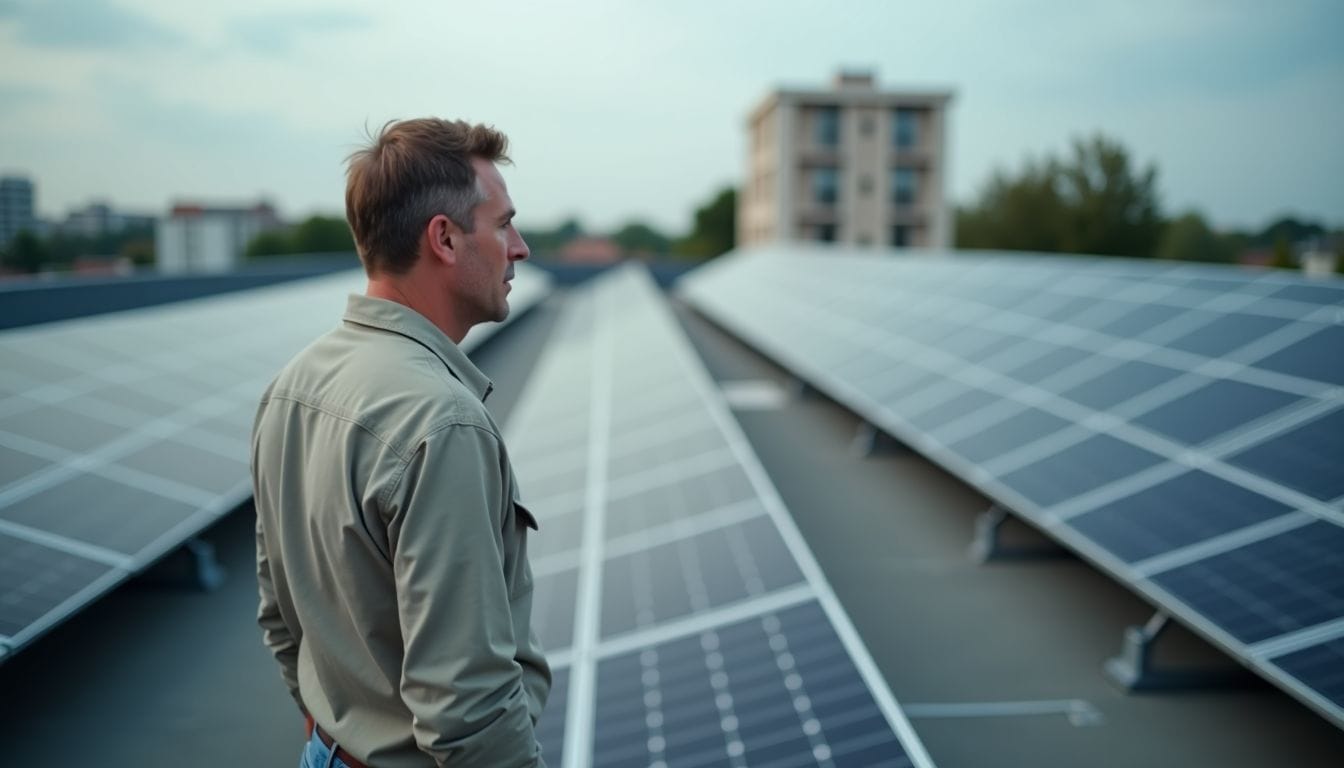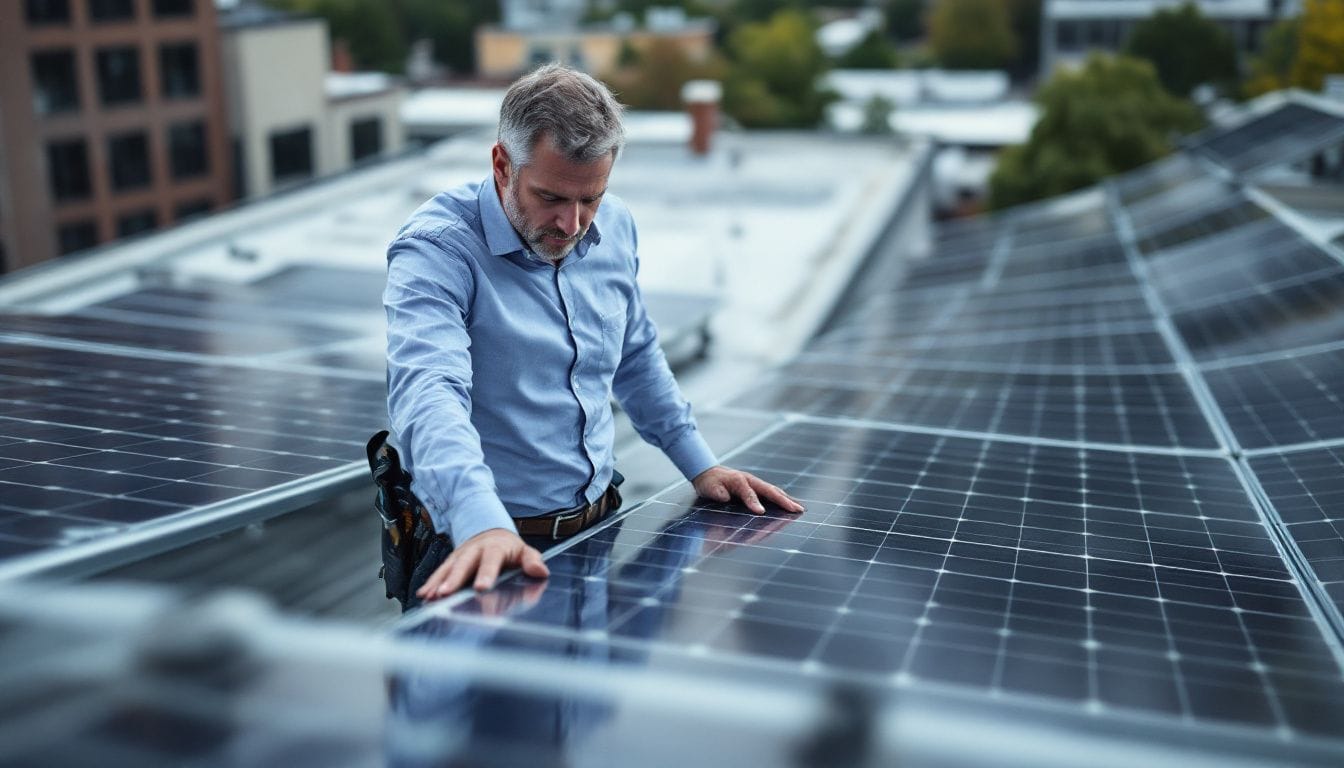Commercial Solar Guide
Energy bills keep rising. Many firms want to cut costs and go green. What is commercial solar? It’s a smart way to do both.
Commercial solar uses big panels on roofs or land. These panels turn sunlight into power for businesses. They can save up to 25% on energy costs from day one.
This guide will explain how commercial solar works. It will show how it can help your firm save money and reduce its carbon footprint. Ready to learn more about this clean energy option?
Key Takeaways
- Commercial solar uses large panels on roofs or land to turn sunlight into power for businesses, saving up to 25% on energy costs from day one.
- A typical commercial solar setup needs at least 5,000 square metres of roof space and can generate up to 180,000 kWh yearly.
- Commercial solar panels are bigger than home panels, measuring 6.5 feet long and weighing 90 pounds, with 72 cells instead of 60.
- Businesses can cut their carbon footprint by up to 80% when switching to solar power, with a 30kW system stopping 25 tonnes of CO2 from entering the air each year.
- Most commercial solar systems pay for themselves in 5-7 years and last 25-30 years, offering long-term financial savings and increased property values.

What Is Commercial Solar?
Commercial solar uses large photovoltaic (PV) panels to turn sunlight into power for businesses. These panels have silicon cells that create an electric field when exposed to light.
A typical setup needs at least 5,000 square metres of roof space. The panels link up to form big solar arrays on rooftops or open land. This system helps firms cut energy costs and lower their carbon footprint.
How Do Commercial Solar Panels Work?
Commercial solar panels capture sunlight and turn it into power. They use photovoltaic cells made of silicon. These cells create an electric field when hit by sunlight. This field pushes electrons through the material, making electricity.
The panels link up to form a solar array. This array connects to an inverter. The inverter changes the DC power from the panels into AC power for use in buildings. Monocrystalline panels work at 15-20% efficiency.
Polycrystalline panels reach 13-17% efficiency. Extra power can go into batteries for later use. Most panels last 25 to 30 years with little drop in output.
Key Differences Between Commercial And Residential Solar Panels
Commercial solar panels differ from residential ones in size and power. These panels measure 6.5 feet long, while home panels are 5.5 feet. They also pack more cells – 72 vs 60 – and weigh 90 pounds compared to 40 pounds for home use.
The scale of systems varies too. Business setups start at 10KW and can reach several megawatts. Home systems range from 3KW to 10KW.
Costs vary between the two types. A typical home solar setup averages £7,000. Business systems cost more due to their larger size and power output. Yet, they often yield greater long-term savings for companies.
The bigger panels and higher cell count allow firms to generate more power from less roof space.
Benefits Of Commercial Solar For Businesses
Commercial solar offers big perks for businesses. It cuts energy costs and boosts green cred, making it a smart choice for forward-thinking firms.
Reduced Energy Costs
Solar panels cut power bills fast. Firms can save up to 33% on electric costs. A 120kW system powers a business using 180,000 kWh yearly. Most setups pay for themselves in under 5 years.
After that, the energy is nearly free. Panels last 25+ years, so savings keep growing.
Firms see big drops in energy spend right away. A typical system saves 25% on power bills from day one. This frees up cash for other needs. As energy prices rise, solar savings grow even more.
It’s a smart way to control costs long-term.
Lower Carbon Footprint
Commercial solar panels slash carbon emissions. Businesses cut their carbon footprint by up to 80% when they switch to solar power. This green energy source produces no harmful gases during operation.
It helps firms meet strict environmental targets and boosts their eco-friendly image. Many companies now use solar to show they care about the planet.
Choosing solar energy makes a real difference to the environment. A typical 30kW system stops 25 tonnes of CO2 from entering the air each year. That’s like taking 5 cars off the road! Solar panels also last for decades, providing clean power for many years.
This long-term green solution helps fight climate change in a big way.
Long Term Financial Savings
Solar panels offer big money savings over time. Most systems pay for themselves in 5-7 years. After that, you’ll enjoy free power for decades. Your energy bills will drop sharply. You may even earn money by selling extra power back to the grid.
Property values also tend to rise with solar installations. This green upgrade makes homes and businesses more attractive to buyers. The long-term savings add up fast, often reaching tens of thousands of pounds over the system’s life.
Maintenance costs stay low too, at about £9.50 per panel each year. This small expense is far outweighed by the ongoing savings. Solar panels typically last 25-30 years, providing decades of reduced energy costs.
As utility rates rise, your savings grow even more. Businesses can cut operating costs and boost profits. Homeowners enjoy lower bills and increased home equity. Either way, solar is a smart long-term investment that keeps paying off year after year.
Challenges Of Commercial Solar Installation
Commercial solar installations face big hurdles. High upfront costs scare off many firms. The end of Feed-in Tariffs cut money incentives. Strict rules and long planning slow projects down.
City shadows from tall buildings lower panel output. UK weather changes make solar power less steady. Storing extra energy costs too much for most. These issues stop more businesses from going solar.
Panels need lots of space, which limits options for some companies. Roofs must be strong enough to hold heavy arrays. Finding skilled workers to fit systems can be hard. Grid connections often delay projects.
Some areas have limits on new solar hook-ups. Keeping panels clean and working well takes time and cash. Despite these snags, solar still helps many firms cut bills and go green.
Financing Options For Commercial Solar Systems
Businesses have several ways to fund solar systems. Power Purchase Agreements (PPAs) offer solar with no upfront costs. Firms pay for the energy they use, often at lower rates than grid power.
Salix Funding gives interest-free capital to UK public sector bodies for green tech.
Solar loans and asset finance boost cash flow and tax benefits. The UK government charges 0% VAT on solar panels, cutting costs further. Smart Export Guarantee (SEG) lets firms sell extra energy to the grid.
By 2025, SEG earnings could reach 5p-15p per kWh. These options make solar more accessible for companies of all sizes.
How To Choose The Right Commercial Solar Provider
Choosing a top commercial solar provider is key. Look for firms with lots of experience in big solar projects. Check their past work and what clients say about them. Make sure they have the right certifications in solar energy.
A good provider will offer custom solutions for your business needs. They should also give support after the install is done. Ask about their full services, from planning to building the system.
The best solar companies do more than just sell panels. They guide you through the whole process. This includes helping with permits and connecting to the power grid. Ask about their panel quality and warranties too.
Good providers use the latest tech to boost your energy output. They’ll also help you find ways to pay for your system. Pick a firm that fits your budget and long-term goals.
Applications Of Commercial Solar Energy
Commercial solar energy powers many business types. Offices, shops, and factories use it to cut costs. Large solar arrays on roofs or open land generate power. A typical system can produce up to 180,000 kWh yearly.
This meets the needs of most firms.
Solar helps companies go green too. It shrinks carbon footprints and boosts eco-friendly reputations. Firms can sign Power Purchase Agreements to start easily. These deals let businesses use solar with no upfront costs.
Solar shows a real push for sustainability. It helps meet ESG goals and attract eco-minded customers.
Future Of Commercial Solar Energy
Solar tech is set to boom in coming years. Experts predict a 46% rise in solar use by 2026. New panels will be more efficient, turning more sun into power. Smart grids will help businesses use solar energy better.
Costs will keep falling, making solar a top choice for firms.
Innovations like solar tiles and windows will change how we see solar. These new tools will fit into buildings smoothly. By 2030, many offices may make their own clean power. This shift will cut carbon and save money for companies big and small.
Conclusion
Commercial solar offers big benefits for businesses. It cuts energy costs and helps the planet. Many firms now choose solar to save money long-term. The tech keeps getting better and cheaper.
More companies will likely switch to solar soon. It’s a smart move for any business looking to grow and go green.
FAQs
1. What’s commercial solar?
Commercial solar is a type of solar power system for businesses. It’s bigger than home solar but smaller than utility-scale solar. These systems help firms cut energy costs and go green.
2. How does commercial solar differ from domestic solar?
Commercial solar is for companies, while domestic solar is for homes. Business systems are larger and often use more panels. They can power big buildings like warehouses or offices.
3. What are the benefits of commercial solar?
Commercial solar offers energy savings and helps the environment. It can lower electric bills, provide tax breaks, and boost a company’s green image. Many businesses see it as a smart investment.
4. How much do commercial solar panels cost in the UK?
The cost varies based on system size and type. Prices range from £16,000 to £70,000 or more. Factors like panel quality and installation complexity affect the final price. But remember, it’s an investment that pays off over time.
5. Are there any drawbacks to commercial solar?
Some cons include high upfront costs and the need for roof space. Weather can affect power output. Also, some systems need regular upkeep. But for many, the pros outweigh these issues.
6. How do businesses get started with commercial solar?
First, chat with a solar installer. They’ll check your energy needs and roof space. Then, they’ll suggest a system that fits your budget. After that, it’s about picking panels and setting up installation. Soon, you’ll be harnessing the sun’s power!

